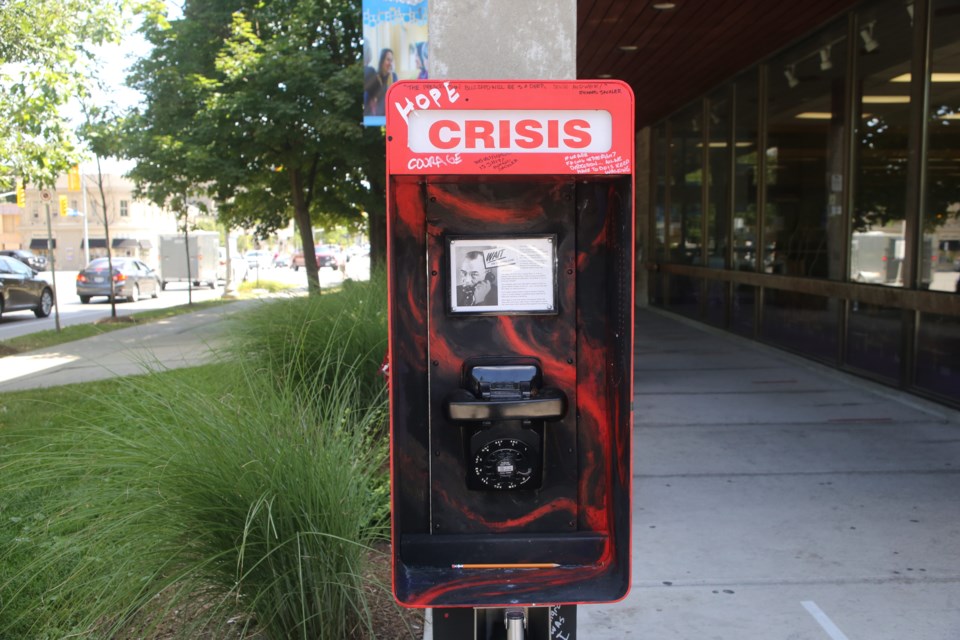A new art installation outside the main Guelph Public LIbrary is meant to be a memorial to people lost to overdose deaths and to start a conversation on how to prevent others.
Crisis Phone 2020 is an art installation that will be on display for the next six months outside the Norfolk Street library. It consists of a decommissioned public telephone that has been painted red and black with quotes scrawled in either black or white paint.
The project is intended as a reflection on the opioid crisis and the impact it is having on the community in Guelph.
The installation consists of a standalone public telephone which has been repainted and covered in quotations relevant to the conversation.
At its heart is a black telephone and below it where the phone book would be found are empty pages that can be filled by people passing by.
“I love that it is interactive,” said Adrienne Crowder, manager of the Wellington-Guelph Drug Strategy. “It’s an organic piece. As people leave their comments, it changes.”
The piece was created, in part, to coincide with the upcoming Overdose Awareness Day, which will be marked in Guelph on Monday.
Crowder said raising awareness is more important than ever as the trends for overdoses and opioid deaths are headed in the wrong direction. She said Crisis Phone 2020 has the potential to start a conversation every time someone passes by it.
“It’s an opportunity for the community to create some collective energy around this year’s Overdose Awareness Day,” said Crowder.
She hopes the location of the piece outside the main library on Norfolk Street will broaden that conversation past the people who usually show up for Overdose Awareness Day.
“It’s a very public space and a space accessed by everybody in the community,” said Crowder.
Although it is signed ‘anonymous’, the creator of the piece is local artist and Guelph city councillor Mike Salisbury.
“I had written anonymous on it because it really isn’t about me, it’s about the issue,” said Salisbury by phone on Wednesday.
The art installation is intended as part memorial, part community conversation and social commentary.
“Part of it is the symbolism of the unanswerable help phone,” said Salisbury. “It’s not particularly positive, but in regards to the opioid crisis it’s not entirely inaccurate. Yes we have to do something, but am I particularly optimistic? No I’m not.”
He hopes to see the empty pages on the installation filled during the time it is on display.
“Maybe you’re grieving and you can express that, or maybe you can’t express it because of the stigma. You can write about it and as soon as you close that book it’s gone,” said Salisbury.
He concedes that comments may not always be in support of stopping the stigma associated with drug use.
“Maybe you’re angry and don’t believe addiction is a disease and think it’s a choice and that those people should be put in jail and you’re not allowed to say that because it’s politically incorrect in your circles, well you can express those opinions because its a safe place to do that,” said Salisbury.
Even the quotes scrawled on the piece itself alternate between those that are supportive and those that are not.
“It’s intended to provoke and begin conversation, because not everyone sees this issue the same way,” he said.
The opioid crisis has touched Salisbury directly, most notably through the death of his first wife Ruth to an accidental fentanyl overdose about six years ago.
The couple met while they were teenagers and were married almost 25 years. Salisbury said the piece is partly a tribute to her.
“I found it really hard to do that piece and I find it really hard to be around it,” said Salisbury. “I find it to be uncomfortable, but at the same time I think it needed to be put out. It’s my truth.”
The telephone itself is not operational and does not directly connect to a help line, something Salisbury said he has received some negative feedback about.
“If everybody has a cell phone and they are three digits away from help and it isn’t making a difference, I don’t think an art installation is going to save the day or change the outcome,” he said. “But it is going to start the conversation.”
